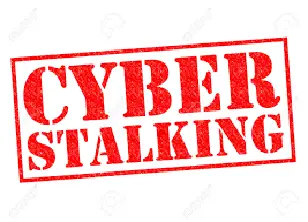What is Cyberstalking
Cyberstalking is a type of cybercrime where the criminal uses online means to harass a person or an organization. The word “online” refers to anything digital such as emails, instant messages, chats, status updates, tweets, blogs, comments, social sites, etc. It just occurred to me looking at the above paragraph that people easily confuse and call it “Trolling” in the language of social networking. There can be a single person or a group involved in online harassment. You can see many regular examples of trolling on Twitter and Facebook where seemingly normal-looking people continue to defame and hurt others that do not show similar thoughts. But trolling is not cyberstalking. Trolling could have an element of humor – whereas cyberstalking comes with malicious intent. Cyberstalking is bigger… to an extent where it starts showing mental and physical symptoms on the person being stalked. These symptoms can range from stress signals to anxiety and even fright in physical life. A person may be afraid of going out as he or she may think the stalkers are out there, ready to hurt them. This is serious and if you know anyone showing such symptoms, not only call a doctor first but also the anti-cybercrime phone number for that country. In most cases, cybercriminals have the luxury of anonymity provided by the Internet. Some might use advanced techniques such as hiding IPs and using special browsers to confuse the law enforcement authorities if anyone reports them.
Why do people cyberstalk
There can be n number of reasons why people cyberstalk. The most common one is to defame the victim and thereby gain some kind of gratification – in the form of satisfaction or monetary benefits. Since we have talked of “trolling”, I would like to draw your attention to the kind of language and abuses hurled at news media or politicians on Twitter – if you have an account. That is the smallest form of cyberstalking – collecting negative material about them, posting it all over the microblogging site, and promoting the material so that “all others” get to see it. In this particular case, the aim is to defame the victim whereby the person stalking is either paid by opposing parties or gets a sense of satisfaction that he or she is “exposing” the media or person whom we can call the victim in this case. I am listing the reasons I can think of, in the order of their use: We can conclude two points from the above list:
Cyberstalking – Prevention and Help
They say prevention is the best cure. I will also say it, for the sake of saying… because if a person wants to harm you, he or she’ll find a way to do it. They say if it is personal, keep it offline. I have seen offline material being converted into digital format and posted all over the Internet. As such, there is not much that you can do as a preventive measure – if someone does decide to stalk you. I can say keep your personal information secret, don’t post your images to social networks indiscriminately, don’t tell people anything about yourself on social networking or on blogs, and so on. These are the usual precautions prescribed by everyone else and we all know it is just not possible to stay away from everything. But it is possible to abstain from certain stupid things – like posting your physical address in a tweet to challenge someone, or posting a video of your home that shows all the entrances. Then what should you do to prevent and get help in case of cyberstalking? Keep the phone number of the cyber cells ready. You know you are going to be a victim one day so be ready and seek help. Never let anyone get on your nerves. That is to say, do not wait and allow the stalker to spoil your health – physical or mental… or to achieve their aim to defaming you in public and giving you a hard time. Stop it as soon as it begins. Warn them and if they don’t oblige, take action. And most importantly, don’t get angry or scared. Stay calm and composed and then decide on a plan of action. Once you feel someone is stalking you, collect evidence and call the cyber police in your city. The more evidence you have with you, the better. Evidence, in this case, could be the emails, screenshots of posted messages, tweets, status updates, images posted on blogs or the entire blogs. Take screenshots instead of just noting down the URL. Take fullscreen screenshots as you have to show that they were indeed online and that you did not fabricate the evidence using your own personal collection.
How to report Cyber Stalking
The local police stations are supposed to help with cybercrimes too so you can file a complaint with them. They’ll pass on your complaint to the cybercrime cell. In case you wish to take more action, you can also report the cyberstalking to IC3 website if you live in the US. In India, the local police stations do not do much for cyber stalking. There is a provision in the constitution, but most police stations are not yet equipped to take action against cyber crimes. You can, however, find out your city police’s handles on Twitter and complaints there. For reporting cyber crimes in India, contact the following address: Stay safe! Central Bureau of Investigation, 5th Floor, Block No.3, Lodhi Road, New Delhi 110003 Ph:011-24361271

